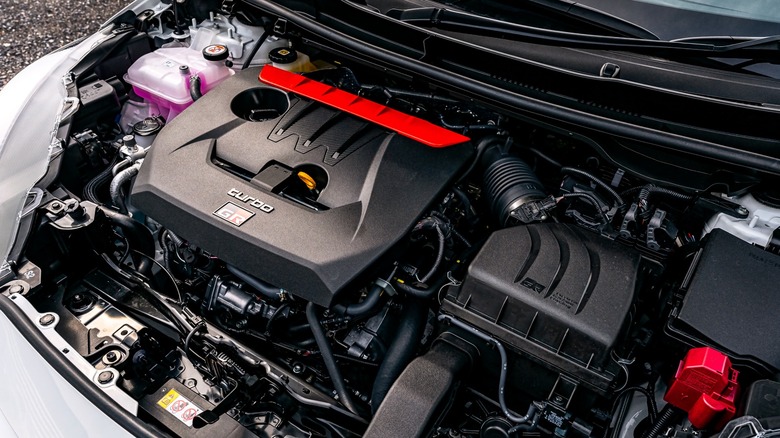
Streetmetal/Shutterstock
When you talk about high output engines, you usually think about cars with lots of cylinders, like V8, V10, V12, or even W16 engines. These powerful engines include the likes of the Bugatti W-16 engine, or these V8 Dodge crate engines. However, advancements in engine design and technology means that you no longer must rely on sheer displacement to deliver power. Forced induction has allowed engine manufacturers to get more power out of smaller engines, thus increasing efficiency.
But more than just saving fuel, the small but powerful engines also save on size and weight, allowing engineers to put more horses in smaller vehicles. So, we’ll list some of the smallest performance engines you can get today. All the engines we have will not go over 2 liters in displacement, and we won’t have more than four cylinders. While some of the engines we will mention will come in hybrid vehicles, we will only look at the engine’s horsepower output, and not the overall power of the car it comes in.
Volkswagen EA888 Evo 4
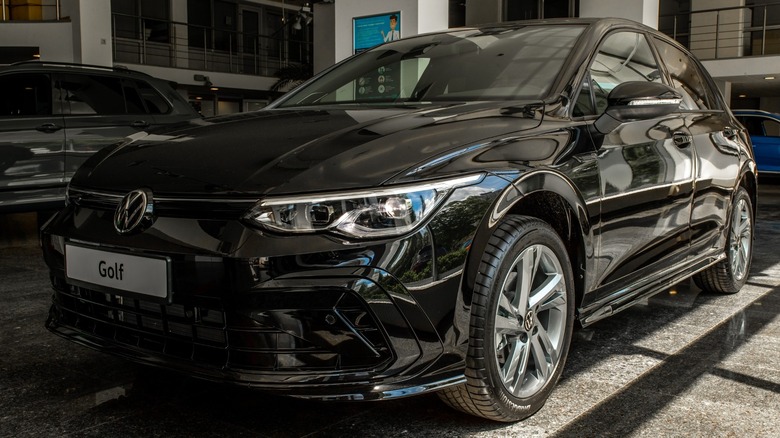
Honcharuk Andrii/Shutterstock
The Volkswagen EA888 is quite a popular engine, after having been introduced in 2004 and added to many VW, SEAT, and Audi models. It’s one of the most reliable VW engines ever made, but its performance Evo 4 version is the one that lands on the list of the most powerful inline-4 engines.
When Volkswagen installed this engine on the 2022 Volkswagen Golf R, the company was able to eke out 329 hp and 310 lb.-ft of torque from this two-liter inline-four engine. This means you get 164.5 hp for every liter this engine has. VW achieved this by adding a turbocharger to force more air into the engine. It also used a cast-iron block with an aluminum alloy cylinder head — a tried-and-tested formula for making dependable and high-performance engines.
Aside from the Golf R, you can also find detuned versions of the EA888 in other vehicles, like the Audi A3 and Volkswagen Tiguan. It’s also available in a smaller 1.8-liter variant, powering more mundane Volkswagen group models, like Jetta, Passat, and Amarok.
Toyota G16E-GTS
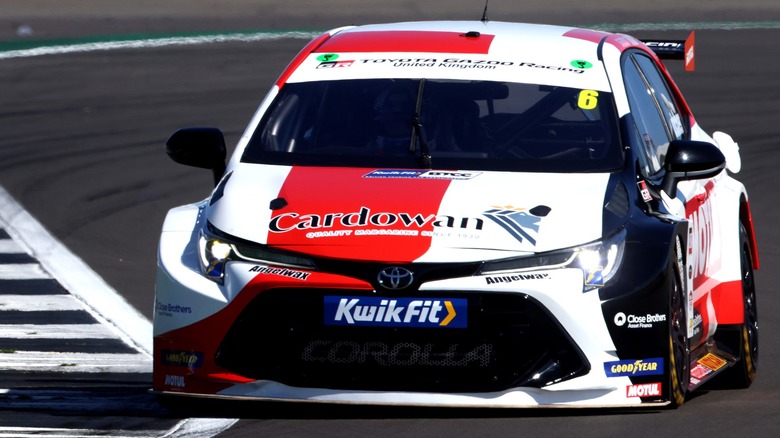
Alex Pantling/Getty
Toyota has recently returned to the hot-hatch scene with its GR Yaris and GR Corolla models. While we did not receive the GR Yaris in the U.S., we at least had the larger GR Corolla to play with. Both hot hatches are based on compact sedans or hatchbacks, so it makes sense for Toyota to put the smallest but most powerful engine it had — the G16E-GTS.
This engine has been tailor-made for the GR Yaris and was later adapted for the GR Corolla. But what makes the G16E more impressive is that it has the smallest displacement of all the engines we have in our list, at just 1.6 liters. This three-cylinder engine can output an astounding 300 hp and 273 lb.-ft of torque, meaning it delivers 187.5 hp/L.
Just like the rest of the engines in this list, the G16E uses a turbo to suck in more air and burn more fuel. At the same time, it uses two cooling jackets for the cylinder heads and a water-cooled oil cooler, allowing the engine to stay cooler for longer, and letting Toyota squeeze more horses out of it.
Volvo VEA B420
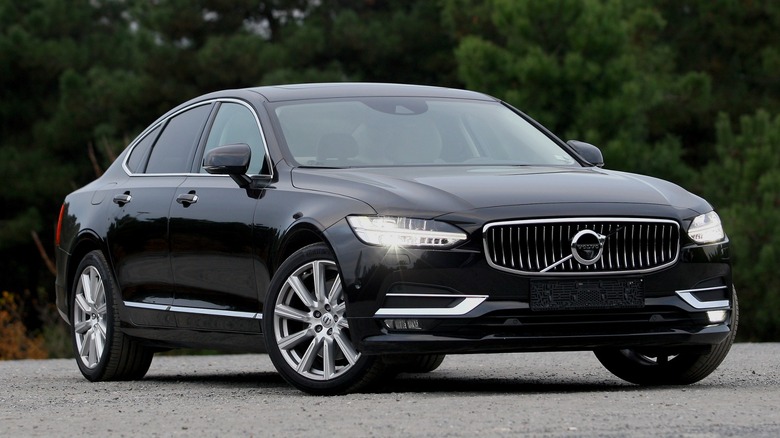
otomobil/Shutterstock
Volvo has promised way back in 2011 that it will make smaller engines without making performance cuts. More than 10 years later and we see that the Swedish car company has stood true to its word with the VEA B420.
The B420 is a part of the VEA engine family, which started production in 2013. Although you can find the VEA engine in practically every Volvo car, the B420 is a special breed, as you can only find it in top-end Volvo models; specifically, the Volvo S90 and the Volvo XC90.
This 2-liter inline-four engine can output 320hp and 295 lb.-ft of torque, giving it 200 hp per liter of displacement. Volvo achieved this by adding a turbocharger and a supercharger to the engine — the latter is used to deliver power immediately, while the turbocharger gives the engine its torque figures and more air at the higher end of the power band.
Daimler-Benz M139
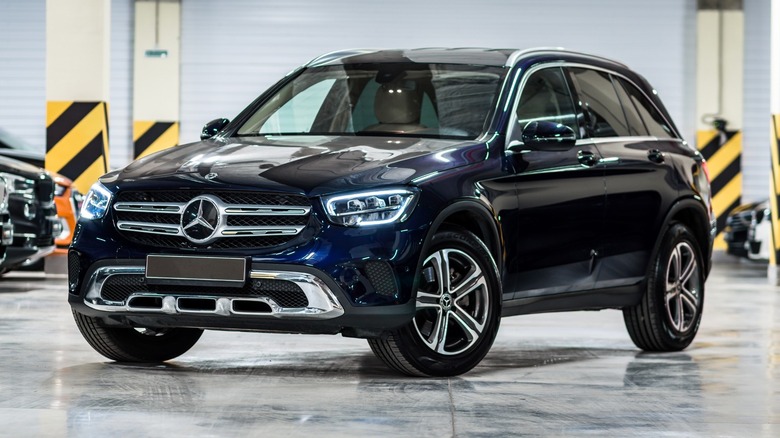
rebinworkshop/Shutterstock
Outside from the Mercedes-AMG ONE with its 1,063 hp hybrid engine, one of the fastest Mercedes-Benz cars you can get today isn’t a supercar, grand tourer, or a coupe. Instead, it’s a four-door sedan called the Mercedes-AMG GT 63. However, this is an expensive beast with a hybrid V8 heart that comes with a six-figure price tag.
If you want something more affordable, you could go for the identical looking Mercedes-Benz CLA AMG 45. But even if this car cheaper than its bigger brother and comes with a smaller four-pot, don’t be fooled — this 2-liter engine can deliver 416 hp and 369 lb.-ft of torque.
But if you want even more power from a four-cylinder engine, then you should look at the Mercedes-AMG GLC 63. The gasoline engine in this SUV puts out 469 hp and 402 lb.-ft of torque, meaning you can squeeze 234.5 horses for every liter that this engine has.
Koenigsegg TFG twin-turbo
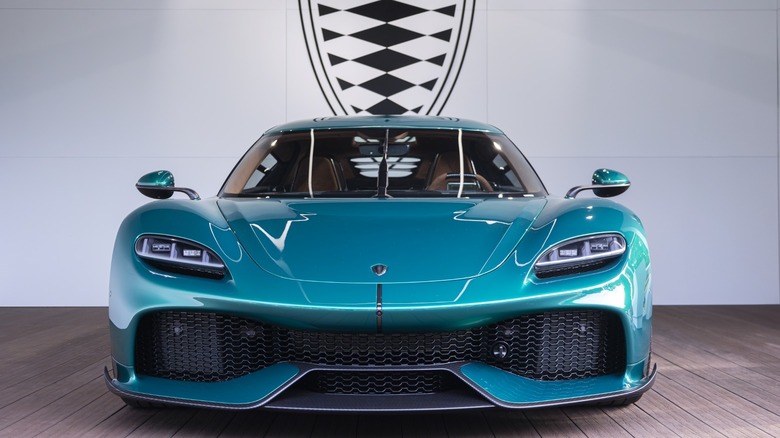
Martyn Lucy/Getty
If you’re an ultra-high net worth individual and want a hypercar, but also want to take your family with you when you drive, then you no longer have to pick between a two-door or a sedan — you can get the best of both worlds with the Koenigsegg Gemera, powered by Koenigsegg’s own TFG, or «Tiny Friendly Giant,» twin-turbo engine and three electric motors.
When combined, you get over 1,700 hp out of the Gemera, but what’s more impressive is its gasoline engine. The TFG is just a 2-liter inline-three, but it can push out 592 hp and 443 lb.-ft of torque with the help of two turbos, delivering an eye-popping 296 hp/L. What’s more impressive is that you don’t have to limit yourself to high-performance fuels. Instead, you can put in Gen 2.0 ethanol, E85, or even other more eco-friendly fuels, and the engine will happily speed along.
When you combine this over 500 hp engine with the three electric motors on the Gemera, you get an absolute beast that can seat a family of four. And with its 3.5-second 0-60 mph record and top speed of 268 mph, you wouldn’t believe that a small three-cylinder engine sits inside it to help its electric motors move along.